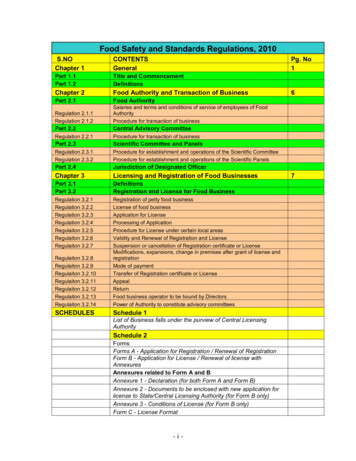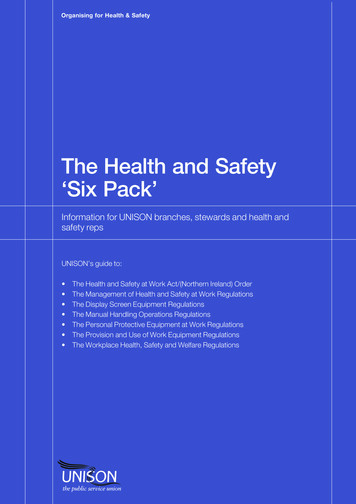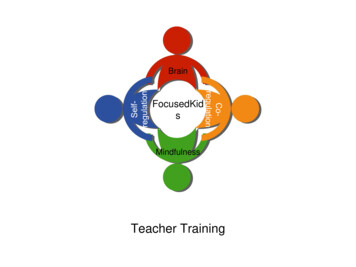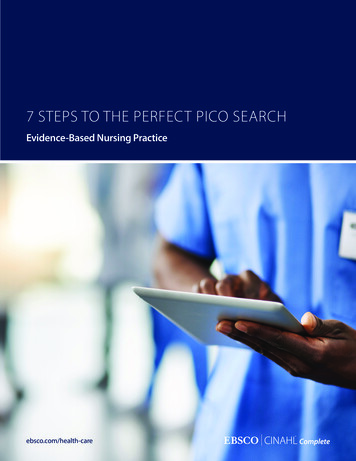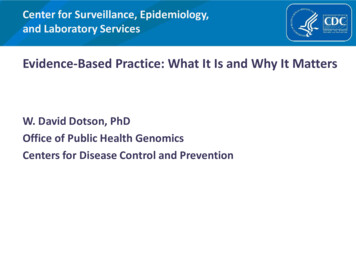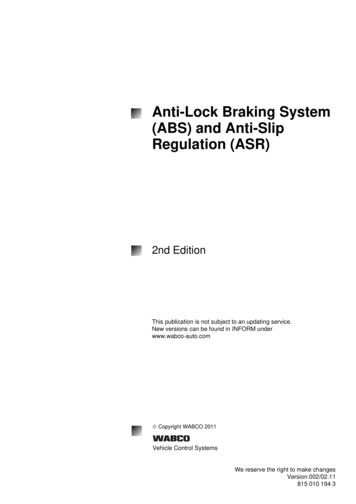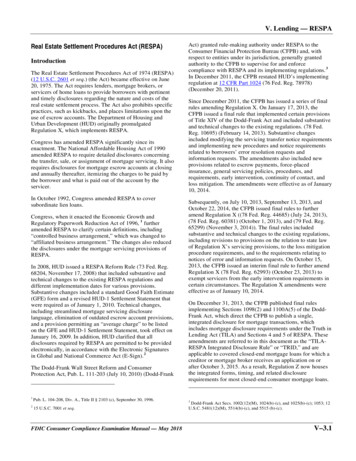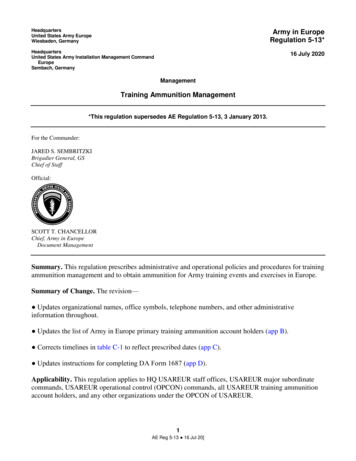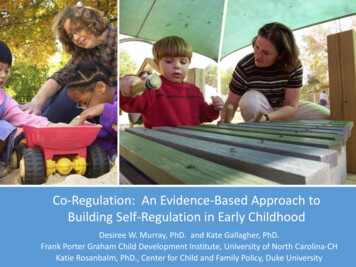
Transcription
Co-Regulation: An Evidence-Based Approach toBuilding Self-Regulation in Early ChildhoodDesiree W. Murray, PhD. and Kate Gallagher, PhD.Frank Porter Graham Child Development Institute, University of North Carolina-CHKatie Rosanbalm, PhD., Center for Child and Family Policy, Duke University
AGENDA Overview of Self-Regulation Influences on Self-Regulation Development Understanding “Co-Regulation” Coaching Self-Regulation2
What is Self-Regulation?3
Self-Regulation IS The act of managing cognition and emotion toenable goal-directed actions such as: organizing behavior controlling impulses solving problems constructivelyMurray et al., 2015. Foundations for understanding self-regulation from an applied developmentalperspective. OPRE Report # 2015-21; Administration for Children and Families. 4
Self-Regulation INCLUDES 5
Self-Regulation in Young ChildrenTurn and Talk What does self-regulation look like during infancy, toddler-hood,preschool? What are some common situations where children have difficultyself-regulating?6
What Skills do Young Children Need toDevelop so they can Self-Regulate?
Self-Regulation in Children with DisabilitiesTurn and Talk What can makeself-regulationmore challenging? What contributesto thesechallenges?8
Why is Self-Regulation Important? Foundational for success in school Predicts wellbeing and positive long-termdevelopment Problems with behavior regulationSuspension and expulsion from child carecenters 8,000 preschoolers suspended every yearDisproportionately boys and Black childrenAbout 20% are children with disabilitiesRates of expulsion 3x as high as for schoolaged childrenMore than 10% of state-funded NCpreschool teachers reported having expelleda childGilliam, 2005, DOE 2014
Connections to the DEC RecommendedPracticesInteractionInstruction INT1. Practitioners promote the child’s INS4. Practitioners plan for and provide thesocial-emotional development bylevel of support, accommodations, andobserving, interpreting, and respondingadaptations needed for the child to access,contingently to the range of the child’sparticipate, and learn within and acrossemotional expressions.activities and routines. INT2. Practitioners promote the child’ssocial development by encouraging the INS9. Practitioners use functionalassessment and related prevention,child to initiate or sustain positivepromotion, and intervention strategiesinteractions with other children andadults during routines and activitiesacross environments to prevent andthrough modeling, teaching, feedback,address challenging behavior.or other types of guided support. INS13. Practitioners use coaching or INT5. Practitioners promote the child’sconsultation strategies with primaryproblem-solving behavior by observingcaregivers or other adults to facilitateinterpreting, and scaffolding in responsepositive adult-child interactions andto the child’s growing level of autonomyinstructionand self-regulation.Division for Early Childhood. (2014).10
What Influences Self-Regulation?11
How Families InfluenceSelf-Regulation (100 studies) Parental warmth andsensitivity Harsh discipline andmaltreatment Parents’ mental health Buffers the effect ofstressors12
How ECE Programs Influence Self-Regulation Positive Teacher-Child Relationship:- “Protects” from risks of poverty- Promotes academic achievement andsocial adjustment Classrooms with effective behaviormanagement:- Less disruptive, aggressive, andinappropriate behavior- Children more focused on learning Classroom management programswork!- Increase teachers’ effectiveness andreduce stressHamre & Pianta, 2001; Pianta et al., 1995; Silver et al., 2005; Webster-Stratton & Reid, 2007, 2009
How Stress Influences Self-RegulationTraumatic Stress: ACEs and/or theaccumulatedburdens ofpoverty Increasesvulnerability tofuture stressHarvard Center for Developing Child14
Survival Mode in the Context of Stress Leads to a constant state of high alert:o Fighto Flighto Freeze Harder to:o Pay attention/stay on tasko Regulate emotionso Follow ruleso Interact with others15
How Do Young Children Self-Regulate?Turn and TalkWhat are some ways you have observed that young children remaincalm when stressed or calm down after being distressed?16
What Helps to Strengthen Self-Regulationand Reduce Stress?Co-RegulationWarm, responsive caregivingand behavior coaching orscaffoldingSkills InstructionIn cognitive, emotional, andbehavioral domains of selfregulationMurray, Rosanbalm, Christopoulos, 2016. Report 2016-34. Office of Planning,Research, & Evaluation, Administration for Children and Families.17
Understanding Co-Regulation18
“Co-Regulation”Caregivers, educators, and professionals interactwith young children to provide: Warmth, nurturing,and a secure, saferelationship Support, coaching,and modeling tofacilitate a child’sability to understand,express, andmodulate theirfeelings, thoughts,and behavior19
Capacity for Co-Regulation:It Helps to Be MindfulInteractionsInstruction20
MindfulnessAwareness resultingfromnon-judgmentalattention to oursensations, thoughts,and feelingsin the presentmoment21
More mindful HSProfessionals:Home visitors reportedbetter relationshipswith parentsTeachers have lessconflict in theirrelationships withchildren.Whitaker, et al., 2014, 2015
Mindfulness, Depression andTeacher-Child cher ChildRelationshipConflict
MINDFUL MOMENT
Co-RegulationStrategies and Supports26
Co-Regulation in Action A co-regulating teacher/practitioner will Buffer children from stress and adversity in theenvironment Provide a warm, responsive presence in times ofdistress Provide consistent structure and positive discipline Teach and model self-regulation skills Monitor, prompt, and coach the use of skills27
Co-Regulation for InfantsInfants Interact in warm and responsive ways Anticipate and respond quickly to child’s needs Provide physical and emotional comfort when child isstressed Modify environment to decrease demands and stress28
Co-Regulation for Toddlers What can the parent do to help this childmanage separation? What can the teacher do?29
Co-Regulation for ToddlersToddlers Reassure and calm child when upset by removing childfrom situations or speaking calmly and giving affection Model self-calming strategies Teach rules and redirecting to regulate behavior30
Co-Regulation for Preschool-Aged Children Instruct and coach use ofwords to express emotionand identify solutions tosimple problems Coach rule-following and taskcompletion Model, prompt, and reinforce(or “coach”) self-calmingstrategies when child is upset Provide external structureand consequences31
Coaching Self-Regulation32
What to Coachwith Preschoolers Using words(emotional literacy) Staying calm(emotion regulation) Using ignoring muscles(ignoring) Trying a friend’s idea(social flexibility)
What Else to Coach with Preschoolers Waiting (patience)/ using patience muscles Staying focused and thinking hard (attention) Doing it all by yourself (independence while working) Sticking with something when it is hard (persistence) Trying different ways to solve a problem(flexibility/problem-solving)
What do I actually do and say if I want tocoach self-regulation? Describe examples of self-regulation that you see, usingdescriptive commenting:- “You are .”- “I see .”- “It looks like .” Praise self-regulation behaviorsI bet you will If a child is having trouble regulating:- Give coping statement- Make a positive prediction
Self-Regulation Coaching in Action(Vignette)Turn and Talk How is this teacher coaching? How are you using coaching currently? Is there anything new you might want to try with coaching?36
What do you do to help childrenlearn self-regulation skills?Turn and Talk
When are good times to help childrencalm down?InterveneHereIrritabilityand ExplosivenessInterveneHereCalm
Teaching Calm-Down Strategies Talk about and model coping withfrustration or anger Practice calm-down skills like: Deep Breathing Smell the flower, blow out the candle Imagery Imagine you are relaxing in a soft cloud Think of happy place Positive self-talk “I can do it” “Everyone makes mistakes”
Space and Materials to Support Calming DownTurn and Talk How might you use a calm-down spot in your classroom? What materials might you include in a calm-down spot? What rules might you set for your calm-down spot?40
Take Homes Self-regulation:- Contributes to functioning throughout life- Can be taught like literacy- Is harder for those with significant stress- Is strengthened by structured classrooms with warm,supportive teachers Co-regulation:- Supports self-regulation in moment- Builds skills developmentally- Depends in part on teachers’ own self-regulation skills- Produces significant improvement in child skills andbehavior!41
-Can be taught like literacy-Is harder for those with significant stress-Is strengthened by structured classrooms with warm, supportive teachers Co-regulation:-Supports self-regulation in moment -Builds skills developmentally -Depends in part on teachers' own self-regulation skills-Produces significant improvement in child skills and behavior!
